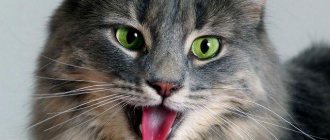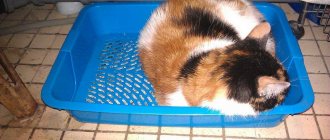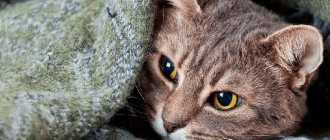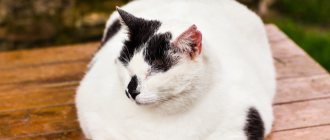A fluffy pet delights the child and improves the mood of the parents. If a family notices that the cat is wheezing and coughing, as if choking, or that the cat is making strange sounds, they are very worried and do not know what to do to help the pet. A symptom that frightens pet owners occurs both with serious diseases that require immediate elimination, and with ingestion of hair, from which the pet gets rid of itself.
Main causes of difficulty breathing
Below we will look at the main causes of difficulty breathing in cats, in the presence of which the pet must be shown to a specialist.
Practicing veterinarians often identify two typical predisposing factors:
- Firstly, these are all types of colds and inflammatory diseases. In this case, the trigger is sudden hypothermia or another reason for a strong decrease in immunity. Pathogenic and conditionally pathogenic microflora are activated under such conditions, their activity causes inflammation and swelling. The lumen of the respiratory tract narrows, and the inflamed membrane of the pulmonary alveoli can no longer normally absorb oxygen from the air, and the animal begins to suffocate.
- Secondly, all types of allergic reactions. Every year these pathologies become more common. The mechanism of breathing difficulty in this case is even simpler: due to the release of large portions of histamine into the blood, the lumen of the bronchi and pulmonary alveoli narrows greatly, the normal process of gas exchange is disrupted, and the cat begins to experience difficulty breathing.
Chest trauma
It will come as no surprise to anyone that a chest injury can lead to respiratory problems in a cat. But the severity of the injuries themselves, as well as the immediate causes of difficulty breathing, can vary greatly:
- Severe chest bruise. This happens, for example, if a cat got into a fight with its relatives, got hit by a bicycle, etc. In this case, the muscles that came under attack (inspirators and expirators) hurt so much that the cat tries not to breathe deeply and not to move again. Accordingly, the cat’s breathing becomes shallow, jerky, and the animal completely loses its appetite. The animal reacts inadequately to attempts to palpate (feel) the chest, and may even bite and scratch the owner.
- Damage to the ribs, which the animal can also easily “earn” due to strong blows. If even small cracks appear on them, the cat can no longer breathe normally. As in the previous case, breathing becomes very shallow and intermittent, the pet cannot breathe deeply (it is in great pain). As in the previous case, he can react extremely negatively to attempts to feel the chest. Fractures of the ribs are even more severe. In particular, a cat can meow loudly and “hysterically”; sometimes the animal simply loses consciousness from pain.
- The impact and/or fragments of broken ribs damaged the pleura or the lungs themselves. In this case, pulmonary hemothorax may develop, i.e. a pathological condition in which blood accumulated in the chest cavity compresses the lungs. At the same time, the animal panics, cannot breathe, meows hoarsely, and all visible mucous membranes instantly turn blue. If nothing is done, the pet will die from blood loss.
Treatment is exclusively in a clinical setting; in severe cases, surgical intervention is indicated.
Asthma
One of the most common causes of wheezing and coughing in cats is asthma. This is a disease accompanied by pathological narrowing of the lumen of the bronchi and bonchioles. Since air enters the lungs through them, aspiration of the organ sharply worsens, resulting in suffocation. The exact cause of asthma is still not known. It is believed that in most cases the culprit is a tendency to allergies.
The following factors provoke the development of attacks:
- Dust, smoke, and other fine aerosols in the air. Cigarette smoke and dust from ongoing repair work are especially dangerous. If the cat is asthmatic, then he needs to be relocated somewhere during the repairs.
- Direct allergy.
- Stress and other psycho-emotional factors. It is known, for example, that strong feelings, fear, etc. are extremely contraindicated for asthmatic people, since all this provokes attacks.
Symptoms of asthma are as follows:
- The cat suddenly begins to choke, at the same moment the animal begins to panic greatly.
- The animal tries to inhale air with noise and wheezing, the visible mucous membranes turn blue.
- During an attack, a cough often develops. In some cases it is so strong that the animal vomits.
- In addition to a strong and uncontrollable cough, an asthmatic cat may suffer from involuntary bowel and bladder emptying.
- A sick cat's nostrils often discharge large amounts of mucous exudate.
Unfortunately, today we have not yet learned how to treat asthma. Treatment is supportive, symptomatic therapy, the goal of which is to achieve long-term remission.
Antitussives, expectorants and mucolytics are prescribed, as well as specific medications for asthma.
Tracheal collapse
In general, tracheal collapse is considered exclusively a canine disease, but the pathology also occurs in cats (though quite rarely). If in dogs its development is often explained by genetic predisposition (there are several of the most “risky” breeds), then with cats everything is much more complicated; no one knows the exact cause of the disease.
With this pathology, the cartilaginous rings of the organ “fold” and sag, causing the lumen of the organ to sharply narrow. The degree of narrowing depends on the stage of the disease (there are four in total). If at the first the trachea differs little from healthy, then at the fourth its lumen decreases to such an extent that the pet may well die from suffocation.
All this leads to the development of the following symptoms:
- The first sign of impending collapse is a cough. And this is not just a slight cough. When collapsed it is loud, ringing and “metallic”. In the third and fourth stages of collapse, the animal coughs and wheezes at the same time so that it seems that it is about to die.
- The pet's fatigue increases sharply. The cat no longer runs or plays. Firstly, he simply does not have enough air for prolonged physical activity. Secondly, the slightest exertion again causes severe coughing attacks.
- The visible mucous membranes of a sick pet are always (starting from the third stage) slightly bluish due to lack of oxygen.
Drug treatment (in the form of antitussives and mucolytics) helps only at first. Only an operation during which some parts of the “native” trachea are replaced with implants will really save your pet from suffering.
Entry of a foreign body into the respiratory tract
All of the above cases are united by their “graduality”; the disease develops over some time. But getting a foreign body into a cat’s respiratory tract is another matter.
Symptoms in this case increase rapidly:
- The cat suddenly and for no apparent reason begins to cough and wheeze.
- Rapidly (within a couple of minutes maximum) all visible mucous membranes turn blue.
- As a rule, the attack becomes more severe within a few minutes; if no measures are taken, the pet may die from suffocation.
The foreign bodies themselves can be: pieces of food, small household garbage, small parts of children's toys (and small toys themselves), which cats also like to play with, etc. Treatment in many cases involves surgical removal of the foreign body.
If the “plug” is nearby and is clearly visible in the cat’s mouth, you can try to pull it out yourself. Since two fingers are unlikely to fit into a cat’s throat, we recommend using surgical clamps or tweezers.
Important! But if you are not confident in your abilities, or if something fragile, like a fish bone, is stuck in the respiratory tract, it is better to seek the help of a veterinarian! “Amateur activities” can be very costly for your pet.
Parasites as a cause of difficulty breathing
Sometimes shortness of breath, wheezing and coughing are caused by parasites. Note that in nature there are varieties of parasitic worms that live directly in the lungs, but in our latitudes, cases of infection with them are rare. But the parasitic etiology of cough is detected quite often...
The point is the peculiarities of the life cycle of parasitic nematodes (ascaris, or roundworms). Their larvae, having emerged from the eggs in the intestinal lumen, do not remain there. They “drill” the walls of the organ, penetrate the nearest blood vessel, and then travel to the lungs. There the larvae live and grow for two or three weeks. Actually, their activity, as well as the intestinal microflora that enters the organ with them, causes massive inflammation of the parenchyma of the latter.
The clinical picture develops as follows:
- Coughing, wheezing and other signs of respiratory problems develop over several days.
- Coughing attacks, accompanied by coughing and “bubbling” in the pet’s chest, always worsen in the evening and at night. Sometimes the cough is so severe that it is accompanied by vomiting.
- Microscopic examination of the secreted sputum reveals many parasite larvae.
- If there are already adult individuals in the cat’s intestines, then they are sometimes found in the vomit (with a strong cough).
Treatment is relatively simple and consists of prescribing loading doses of anthelmintic drugs and antibiotics (to destroy secondary bacterial microflora).
Neoplasms
Unfortunately, neoplasms are a common cause of chronic cough in older cats. Most often, malignant tumors (i.e. cancer) are “blamed”, but benign polyps can also greatly worsen the pet’s health.
Owners should pay attention to the following symptoms:
- Respiratory problems with tumors develop slowly, sometimes over several months, while benign tumors can continue to grow for years.
- With cancer, the animal’s condition quickly deteriorates, weakness increases, and the cat stops running and playing. Note that in the initial stages of tumors, one of the most important symptoms is the pet’s sudden, excessive appetite. He subsequently disappears.
- The frequency and duration of attacks are constantly increasing.
Since oncology is deadly, you should notify your veterinarian at the slightest suspicion. Old cats must be shown to a specialist at least once a quarter, for preventive purposes. Treatment depends on the stage and type of tumor. In many cases, chemotherapy or radiotherapy is prescribed, but at the slightest opportunity, veterinarians prefer surgery: only with the help of surgery can the animal be cured with at least some guarantee of complete success.
Stress and psycho-emotional reasons
As a rule, stress and psycho-emotional reasons in cats do not often lead to breathing problems. But this statement is only partly true. There are several breeds of cats that are characterized by an overly emotional disposition and even some odd behavior:
- Persian cats.
- Siamese and crossbred animals based on them.
- “Good-natured giants”, Maine Coons, can be very aggressive.
Some representatives of these breeds are characterized by short-term (and sometimes not very short) outbursts of anger. In this case, the cat may lose control of itself, breathe hoarsely and quickly, and meow loudly and protractedly. Trying to calm him down costs yourself more. If this happens constantly, you need to consult a veterinarian about prescribing sedatives and medications to correct the animal’s behavior.
What should an owner do if a cat is breathing frequently?
The owner of the animal should first determine the nature of the causes of tachypnea. To do this, you need to compare the condition, appearance and behavior of the pet. Based on observations, we can draw a conclusion about the physiological or pathological causes of the animal’s condition.
In the first case (active games, stress), you should simply give the cat time to restore its normal breathing rhythm. Conditions are created for the animal's peace and comfort. For example, if a cat overheats, be sure to give it something to drink and cool the areas of large vessels (armpits, belly, paw pads).
If you suspect a pathology, you should carefully examine the animal, check the integrity of the ribs and limbs. If an injury is detected, you need to quickly take the cat to the doctor.
A veterinarian’s consultation and treatment will be needed in any case if the animal’s condition does not improve within 3 hours, and the cat’s heavy breathing is accompanied by pathological symptoms. If tachypnea persists without physical exertion, overheating or stress, the animal must be examined by a specialist.
Additional symptoms accompanying coughing attacks
If you pay attention to some additional symptoms, you can learn more about the nature of the disease and its true root causes. Some clinical signs are a reason to urgently, immediately call a veterinarian.
Wheezing when breathing
In general, wheezing when a cat breathes is a very common symptom and can appear in many cases:
- Pneumonia and bronchitis.
- Chest injuries.
- Asthma and allergic reactions.
- Entry of foreign bodies into the lumen of the respiratory system.
- Presence of larvae of parasitic worms, etc. in the lungs.
Thus, you should not focus on wheezing in the diagnostic process, because they appear almost always.
The cat is coughing and choking
If a cat is coughing and choking, this may indicate the presence of the following pathologies:
- Pneumonia and bronchitis.
- Tracheal collapse.
- About the presence of parasites in the respiratory system.
- This often happens when foreign bodies enter the lumen of the respiratory system.
- A persistent cough may be a sign of terminal stages of cancer.
If periods of asphyxia immediately follow a strong cough or occur at the same time as the last one, this can still be considered “normal.” In cases where the cat first begins to wheeze and choke, and only then coughs, you should immediately consult a veterinarian! Such symptoms often indicate a foreign body in the lumen of the respiratory system and other deadly pathologies.
Cat gasps with tongue hanging out
In cases where a cat is choking with its tongue hanging out, the animal may suffer from the following types of diseases:
- Entry of foreign bodies into the lumen of the respiratory system.
- Asthma and allergies.
- There is a good chance that your pet is simply too hot. In older cats and overweight animals, hyperthermia is not uncommon.
- Advanced cases of bronchitis, as well as pneumonia. In some situations, there is almost no healthy parenchyma left in the organ, and the animal simply cannot breathe.
- It is possible that somewhere in the cat's lungs there was a tumor that began to collapse. Its “fragments” plug the airways.
If during attacks of choking your pet’s protruding tongue noticeably turns blue and even swells, the situation is bad. Such signs indicate a severe degree of hypoxia.
If the cat does not get help in a timely manner, it may well die. We recommend calling a veterinarian immediately!
The cat suffocates while sleeping
If a cat suffocates during sleep, this is a more specific symptom, in many cases “signaling” the following:
- The presence of larvae of parasitic worms in the respiratory system of a cat.
- Transition from the second stage of tracheal collapse to the third. True, in such cases the pet not only suffocates, but also coughs very much.
- Some cases of asthma.
Therapeutic techniques
In the clinic, after clearing the airways, the veterinarian can start breathing using artificial respiration, inserting an endotracheal tube and connecting to a ventilator. An indirect cardiac massage, a defibrillator and injections of drugs (adrenaline, atropine, atipemazole, etc.) help a specialist to start a stopped heart. Depending on the results of resuscitation efforts, studies are prescribed to establish a diagnosis, treatment and further care.
Regular preventive examinations and tests will help identify diseases in the early stages, without leading them to a chronic form. If you have congenital or chronic diseases, you should follow your veterinarian's recommendations for caring for your cat. An attentive and caring owner will always notice suspicious symptoms and seek advice from a specialist, because the life and health of the cat is in his hands.
First aid for a cat with signs of suffocation
I would like to immediately warn breeders: independent first aid for a cat with signs of suffocation is not effective in all cases. So, if foreign bodies enter the respiratory tract or in the terminal stage of tracheal collapse, the best help is to immediately call a veterinarian.
If the cat’s condition does not cause strong fears for its life and health, you can try to help the pet:
- It is necessary to ventilate the room well, without, however, allowing drafts to appear in the future. Fresh and clean air (but not too cold) is the key to the well-being of a sick cat. In the future, it is also worth monitoring indoor air quality.
- In addition, you need to control the air humidity in the room where the sick cat is. The recommendation is especially relevant for city apartments with central heating. Very often the air in them is extremely dry, which can provoke asthma attacks. To avoid their development, you can either use a special humidifier or put an aquarium at home.
- The sick pet is provided with complete rest and other pets and small children are not allowed near it.
- When the attack subsides and the cat calms down at least a little, you can give him a little sweetened, lukewarm water. The drink must be warm, as cold liquid may well provoke a new coughing attack.
Diagnosis of the respiratory system: how a veterinarian determines the presence of diseases
Most often, diagnostics of the respiratory system is carried out using a combined method; a specialist can use several methods at once:
- Auscultation (listening to the chest organs). All you need is a phonendoscope. The method allows you to detect wheezing in the lungs and bronchi.
- Percussion (tapping the chest). In this case, an experienced specialist can quite accurately determine the boundaries of organs, the presence/absence of fluid, etc. Note that the study can give good results only in cases where the qualifications of the specialist performing percussion are sufficiently high.
- X-ray. The technique is simple and cheap; equipment for its implementation is available in almost every large veterinary clinic. However, sufficiently high-quality images can be obtained only if special contrast compounds are introduced into the animal’s blood before the study. The pictures are clearer and it is easier to notice signs of pathologies.
- Ultrasound examination of the chest organs. The technique is also common and, moreover, can provide better data, since the method is excellent for soft tissue studies. But ultrasound is a method, the result of which depends even more on the qualifications of the performer. Therefore, the breeder’s task is to select a really good specialist.
Treatment in clinical and home settings: which therapy is preferable
For diseases of the respiratory system, cat treatment can be used both clinically and at home. Note that only the simplest operations can be performed at home, and in case of serious illnesses such treatment is completely contraindicated.
The owner can do the following independently:
- Give antibiotics.
- Give bronchodilators and mucolytics.
In other cases, treatment can only be carried out in a clinical setting:
- For cancer, foreign bodies and tracheal collapse, surgery is indicated. The same goes for all serious chest injuries.
- For pneumonia and bronchitis, complex broad-spectrum antibiotics are prescribed. In order for the treatment to be effective, pre-seeding is done on nutrient media and the type of pathogen is accurately determined.
- Asthma attacks are treated with powerful antispasmodics and bronchodilators. The veterinarian’s task is to select the minimum effective dose, since the animal will have to “sit” on these drugs for the rest of its life.
Recommendations for the owner
Always have a first aid kit on hand to provide emergency assistance. Include in it all the medications that the doctor recommends (glucocorticosteroids, bronchodilators, antihistamines, etc.). These products, along with your veterinarian's prescriptions, should always be available so you can use them immediately.
Discuss with your veterinarian the possibility of using bronchodilators or other aerosol medications. Using inhalers with special attachments is much more convenient and, most importantly, faster. This means you can quickly eliminate the attack and reduce the risk of side effects when using steroids in tablet or injection form.











